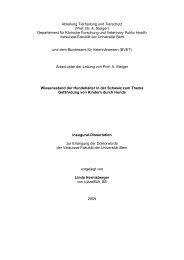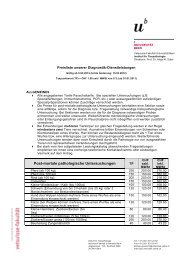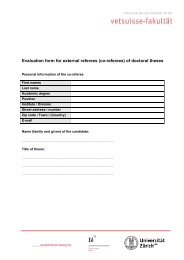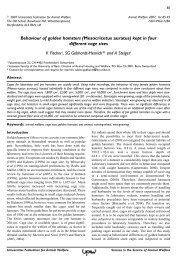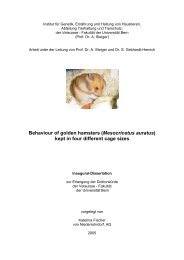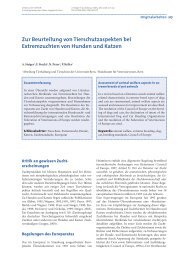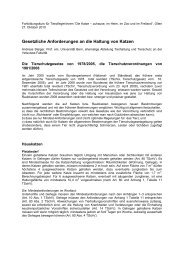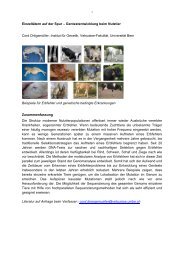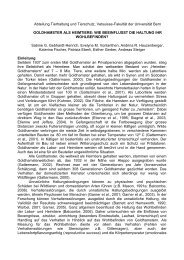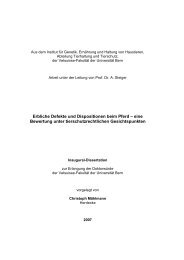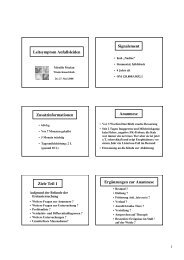Lifespan and Causes of Death in the Irish Wolfhound - Vetsuisse ...
Lifespan and Causes of Death in the Irish Wolfhound - Vetsuisse ...
Lifespan and Causes of Death in the Irish Wolfhound - Vetsuisse ...
Create successful ePaper yourself
Turn your PDF publications into a flip-book with our unique Google optimized e-Paper software.
Fig. 7.3: Recovery <strong>of</strong> <strong>in</strong>breed<strong>in</strong>g depression<br />
contributed by a s<strong>in</strong>gle locus follow<strong>in</strong>g a<br />
bottleneck <strong>of</strong> size 5 as a function <strong>of</strong> time (<strong>in</strong><br />
generations). Values <strong>of</strong> <strong>the</strong> depression have<br />
been multiplied by 10 6 . Upper panel, mildly<br />
recessive mutation with h=0.3 <strong>and</strong> s=0.1.<br />
Lower panel, highly recessive lethal with<br />
h=0.01 <strong>and</strong> s=1.0. For both panels, μ=10 -6<br />
(μ=allelic mutation rate). Arrows on <strong>the</strong> left <strong>of</strong><br />
each panel <strong>in</strong>dicate <strong>the</strong> <strong>in</strong>breed<strong>in</strong>g depression<br />
at equilibrium (upper arrow) <strong>and</strong> immediately<br />
follow<strong>in</strong>g <strong>the</strong> bottleneck (lower arrow).<br />
The ascend<strong>in</strong>g dashed curves show <strong>the</strong><br />
contributions from loci that lose <strong>the</strong> deleterious<br />
allele dur<strong>in</strong>g <strong>the</strong> bottleneck, <strong>and</strong> <strong>the</strong> decl<strong>in</strong><strong>in</strong>g<br />
curves <strong>the</strong> contributions from loci where <strong>the</strong><br />
bottleneck causes <strong>the</strong> mutant frequency to<br />
<strong>in</strong>crease. Graph taken from Kirkpatrick <strong>and</strong><br />
Jarne (2000).<br />
However, Kirkpatrick <strong>and</strong> Jarne (2000) also showed that <strong>the</strong> genetic load can be<br />
expected to fall below basel<strong>in</strong>e some generations after a genetic bottleneck, provided<br />
that population growth is slow <strong>and</strong> <strong>the</strong> deleterious alleles are highly recessive.<br />
Fig.7.4: Recovery <strong>of</strong> <strong>the</strong> genetic load contributed<br />
by a s<strong>in</strong>gle locus follow<strong>in</strong>g a bottleneck <strong>of</strong> size 5<br />
as a function <strong>of</strong> time (<strong>in</strong> generations). Values <strong>of</strong><br />
<strong>the</strong> load have been multiplied by 10 6 . Upper<br />
panel, mildly recessive mutation with h=0.3 <strong>and</strong><br />
s=0.1. Lower panel, highly recessive lethal with<br />
h=0.01 <strong>and</strong> s=1.0 . For both panels, μ=10 -6<br />
(μ=allelic mutation rate). Arrows on <strong>the</strong> left <strong>of</strong><br />
each panel <strong>in</strong>dicate <strong>the</strong> load at equilibrium (lower<br />
arrow) <strong>and</strong> immediately follow<strong>in</strong>g <strong>the</strong> bottleneck<br />
(upper arrow). The ascend<strong>in</strong>g dashed curves<br />
show <strong>the</strong> contributions from loci that lose <strong>the</strong><br />
deleterious allele dur<strong>in</strong>g <strong>the</strong> bottleneck, <strong>and</strong> <strong>the</strong><br />
decl<strong>in</strong><strong>in</strong>g curves <strong>the</strong> contributions from loci<br />
where <strong>the</strong> bottleneck causes <strong>the</strong> mutant<br />
frequency to <strong>in</strong>crease. Graph taken from<br />
Kirkpatrick <strong>and</strong> Jarne (2000).<br />
It must also be kept <strong>in</strong> m<strong>in</strong>d that whenever a population goes through a genetic<br />
bottleneck, substantial r<strong>and</strong>om selection effects can be expected to happen. Thus,<br />
susceptibility to <strong>in</strong>breed<strong>in</strong>g depression <strong>in</strong> populations follow<strong>in</strong>g a genetic bottleneck<br />
can be expected to also be <strong>in</strong>fluenced by r<strong>and</strong>om founder effects (Fowler <strong>and</strong><br />
Whitlock 1999).<br />
100



